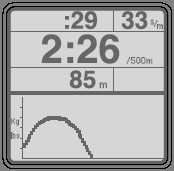 Lets begin by looking at force curves on the erg, because we need some context. As you might expect, C2 have a page all about this (which same page will point you at biorow.com/.../2001RowBiomNews12.pdf but you probably don't want to read that, if you're reading this). I've stolen their picture, I'm sure they won't mind. If you visit their page (do!) you'll find 3 example curves. They call one "ideal" and the other two bad. They are close to correct - indeed, at the level they are talking about they're essentially correct - but its illuminating to look at why they aren't really "correct", because there is no correct answer, at the level to which we're working.
Lets begin by looking at force curves on the erg, because we need some context. As you might expect, C2 have a page all about this (which same page will point you at biorow.com/.../2001RowBiomNews12.pdf but you probably don't want to read that, if you're reading this). I've stolen their picture, I'm sure they won't mind. If you visit their page (do!) you'll find 3 example curves. They call one "ideal" and the other two bad. They are close to correct - indeed, at the level they are talking about they're essentially correct - but its illuminating to look at why they aren't really "correct", because there is no correct answer, at the level to which we're working.At the level to which we're working, what is important above all else is for the whole crew to do the same thing. I'll get onto exactly why this is so in a bit, take it on trust for now. But its easy to see that having the whole crew replicate the "double peak" curve exactly is doomed. Similarly, but a little less obviously, trying to get everyone to do the "exploding at the catch" thing isn't going to work. So the third "ideal" curve is about right but it hides, as they say, a multitude of sins, or rather a multitude of really quite similar but not exactly the same curves, none of which are "ideal" for our purposes.
So what you need to do, as a crew, is agree which of the variants of "ideal" you're aiming for. I've never tried this with a crew, but perhaps you could, on the erg, work through the variants of soft-catches-hard-finishes etc etc, and watch how that affected the power curve, and all agree. The important bit of this would be to all see how varying the speed of the drive in various phases affected the force curve.
On the water
So, why this emphasis on togetherness? Because, remember that bit about how you need to think of the drive as your blade locked in the water, and the boat pushed past as your blade stays still? Well, its correct. You want to move the boat, not the water. Moving the water is wasted effort. Now, think of things not from the perspective you normally do - you, in the boat, watching the water go past - but sitting on the water, just next to the tip of a blade, watching the boat go past and the blade staying still (well, rotating of course as the boat goes past).Now suppose that two people are applying somewhat different force curves: let us say, bow has a harder catch and a softer finish; and 3 has a softer catch and a harder finish; but for the same overall effort during the stroke. Now subtract the average force from both their blades. Oh hold on, I'll draw a picture:
Bow Three
| |
| --> 10 |--> 8
| |
Bow Three
| |
| --> 1 1 <-- |
| |
The top pic shows the forces being applied, in arbitrary units, at the catch.
The bottom pic shows the same thing, but with the average force - 9 - subtracted from both. The difference - plus 1 on one side, minus one on the other side - inevitably goes into compressing the water in between (or, if its the other way round, expanding it. Since water is neither compressible nor expansible, it will just flow away or into). And this force is wasted (actually it isn't quite, because water isn't solid, but some fraction is. And you want that fraction back into moving the boat).If that's not convincing, try thinking of it another way: if the boat is stationary, and bow and three expend the same effort but with bow backing down and three rowing on, the net force on the boat is clearly zero and the boat doesn't move. The above picture is like that, but with the same "forwards" force added to both. But the component by which they are opposing each other is still wasted.
If bow and three represented engines on a jet plane, or on a rocket, this isn't a problem: the total force of 10+8=18 units is available to propel the plane and nothing is lost. If the impetus to push the boat were coming from actually moving the water, then again it wouldn't matter. But insofar as you want the blades to stay locked in the water - and you do - it matters to have everyone applying the same force, at all points in the stroke. Not the same average overall, but the same at all times.
How to achieve that is another matter. But having everyone convinced that it is desireable is a start.
No comments:
Post a Comment